Introduction to Three Dimensional Geometry
Short Answer Type Questions
1. Locate the following points
(i) $(1,-1,3)$
(ii) $(-1,2,4)$
(iii) $(-2,-4,-7)$
(iv) $(-4,2,-5)$
Show Answer
Solution
Given, coordinates are
(i) $(1,-1,3)$
(ii) $B(-1,2,4)$
(iii) $C(-2,-4,-7)$
(iv) $D(-4,2,-5)$
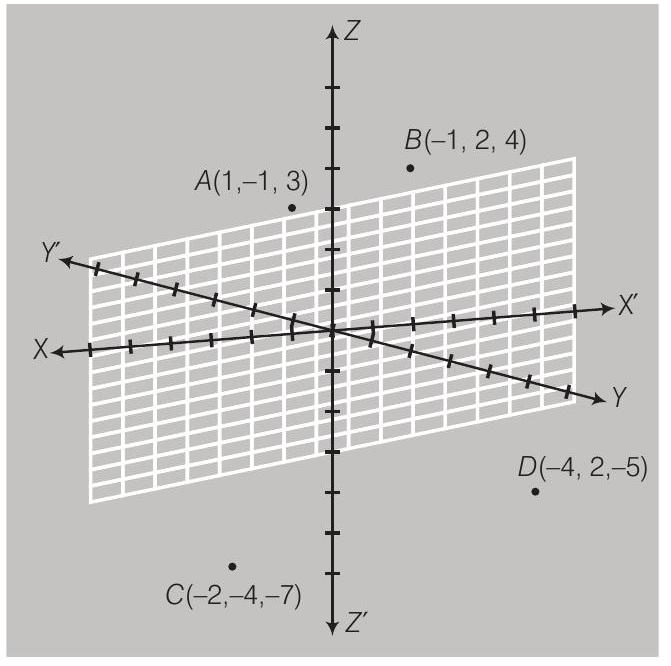
X-increment $=Y$-increment $=Z$-increment $=1$
2. Name the octant in which each of the following points lies.
(i) $(1,2,3)$
(ii) $(4,-2,3)$
(iii) $(4,-2,-5)$
(iv) $(4,2,-5)$
(v) $(-4,2,5)$
(iv) $(-3,-1,6)$
(vii) $(2,-4,-7)$
(viii) $(-4,2,-5)$.
Show Answer
Solution
(i) Point $(1,2,3)$ lies in first quadrant.
(ii) $(4,-2,3)$ in fourth octant.
(iii) $(4,-2,-5)$ in eight octant.
(iv) $(4,2,-5)$ in fifth octant.
(v) $(-4,2,5)$ in second octant.
(vi) $(-3,-1,6)$ in third octant.
(vii) $(2,-4,-7)$ in eight octant.
(viii) $(-4,2,-5)$ in sixth octant.
3. If $A, B, C$ be the feet of perpendiculars from a point $P$ on the $X, Y$ and $Z$-axes respectively, then find the coordinates of $A, B$ and $C$ in each of the following where the point $P$ is
(i) $A(3,4,2)$
(iii) $C(4,-3,-5)$
(ii) $B(-5,3,7)$
Show Answer
Solution
The coordinates of $A, B$ and $C$ are the following
(i) $A(3,0,0), B(0,4,0), C(0,0,2)$
(ii) $A(-5,0,0), B(0,3,0), C(0,0,7)$
(iii) $A(4,0,0), B(0,-3,0), C(0,0,-5)$
4. If $A, B$, and $C$ be the feet of perpendiculars from a point $P$ on the $X Y, Y Z$ and $Z X$-planes respectively, then find the coordinates of $A, B$ and $C$ in each of the following where the point $P$ is
(i) $(3,4,5)$
(ii) $(-5,3,7)$
(iii) $(4,-3,-5)$
Show Answer
Solution
We know that, on $X Y$-plane $z=0$, on YZ-plane, $x=0$ and on ZX-plane, $y=0$. Thus, the coordinate of $A, B$ and $C$ are following
(i) $A(3,4,0), B(0,4,5), C(3,0,5)$
(ii) $A(-5,3,0), B(0,3,7), C(-5,0,7)$
(iii) $A(4,-3,0), B(0,-3,-5), C(4,0,-5)$
5. How far apart are the points $(2,0,0)$ and $(-3,0,0)$ ?
Show Answer
Thinking Process
Distance between two points $(x_1, y_1, z_1)$ and $(x_2, y_2, z_2)$
$ d=\sqrt{(x_1-x_2)^{2}+(y_1-y_2)^{2}+(z_1-z_2)^{2}} . $
Solution
Given points, $A(2,0,0)$ and $B(-3,0,0)$
$ A B=\sqrt{(2+3)^{2}+0^{2}+0^{2}}=5 $
6. Find the distance from the origin to $(6,6,7)$.
Show Answer
Solution
Distance from origin to the point $(6,6,7)$
$ \begin{aligned} & =\sqrt{(0-6)^{2}+(0-6)^{2}+(0-7)^{2}} \quad[\because d=\sqrt{(x_1-x_2)^{2}+(y_1-y_2)^{2}+(z_1-z_2)^{2}}] \\ & =\sqrt{36+36+49} \\ & =\sqrt{121}=11 \end{aligned} $
7. Show that, if $x^{2}+y^{2}=1$, then the point $(x, y, \sqrt{1-x^{2}-y^{2}})$ is at a distance 1 unit form the origin.
Show Answer
Solution
Given that, $x^{2}+y^{2}=1$
$\therefore \quad$ Distance of the point $(x, y, \sqrt{1-x^{2}-y^{2}})$ from origin is given as
$ \begin{aligned} d & =|\sqrt{x^{2}+y^{2}+(\sqrt{1-x^{2}-y^{2}})^{2}}| \\ & =|\sqrt{x^{2}+y^{2}+1-x^{2}-y^{2}}|=1 \end{aligned} $
Hence proved.
8. Show that the point $A(1,-1,3), B(2,-4,5)$ and $C(5,-13,11)$ are collinear.
Show Answer
Thinking Process
If the three points $A, B$, and $C$ are collinear, then $A B+B C=A C$.
Solution
Given points, $A(1,-1,3), B(2,-4,5)$ and $C(5,-13,11)$.
$ \begin{aligned} A B & =\sqrt{(1-2)^{2}+(-1+4)^{2}+(3-5)^{2}} \\ & =\sqrt{1+9+4}=\sqrt{14} \\ B C & =\sqrt{(2-5)^{2}+(-4+13)^{2}+(5-11)^{2}} \\ & =\sqrt{9+81+36}=\sqrt{126} \\ A C & =\sqrt{(1-5)^{2}+(-1+13)^{2}+(3-11)^{2}} \\ & =\sqrt{16+144+64}=\sqrt{224} \\ \because \quad A B+B C & =A C \\ \Rightarrow \quad \sqrt{14}+\sqrt{126} & =\sqrt{224} \\ \Rightarrow \quad \sqrt{14}+3 \sqrt{14} & =4 \sqrt{14} \end{aligned} $
So, the points $A, B$ and $C$ are collinear.
9. Three consecutive vertices of a parallelogram $A B C D$ are $A(6,-2,4)$, $B(2,4,-8)$ and $C(-2,2,4)$. Find the coordinates of the fourth vertex.
Show Answer
Solution
Let the coordinates of the fourth vertices $D(x, y, z)$.
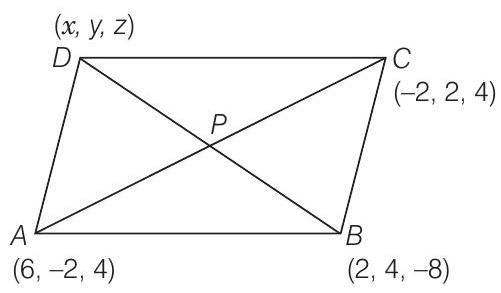
Mid-points of diagonal $A C$,
and
$ \begin{aligned} & x=\frac{x_1+x_2}{2}, y=\frac{y_1+y_2}{2}, z=\frac{z_1+z_2}{2} \\ & x=\frac{6-2}{2}=2, y=\frac{-2+2}{2}=0, z=\frac{4+4}{2}=4 \end{aligned} $
Since, the mid-point of $A C$ are $(2,0,4)$.
Now, $\quad$ mid-point of $B D, 2=\frac{x+2}{2} \Rightarrow x=2$
$\Rightarrow \quad 0=\frac{y+4}{2} \Rightarrow y=-4$
$\Rightarrow \quad 4=\frac{z-8}{2} \Rightarrow z=16$
So, the coordinates of fourth vertex $D$ is $(2,-4,16)$.
10. Show that the $\triangle A B C$ with vertices $A(0,4,1), B(2,3,-1)$ and $C(4,5,0)$ is right angled.
Show Answer
Thinking Process
In a right angled triangle sum of the square of two sides is equal to square of third side.
Solution
Given that, the vertices of the $\triangle A B C$ are $A(0,4,1), B(2,3,-1)$ and $C(4,5,0)$. Now,
$ \begin{aligned} A B & =\sqrt{(0-2)^{2}+(4-3)^{3}+(1+1)^{2}} \\ & =\sqrt{4+1+4}=3 \\ B C & =\sqrt{(2-4)^{2}+(3-5)^{2}+(-1-0)^{2}} \\ & =\sqrt{4+4+1}=3 \\ A C & =\sqrt{(0-4)^{2}+(4-5)^{2}+(1-0)^{2}} \\ & =\sqrt{16+1+1}=\sqrt{18} \end{aligned} $
$ \begin{matrix} \because & A C^{2}=A B^{2}+B C^{2} \\ \Rightarrow & 18=9+9 \end{matrix} $
Hence, vertices $\triangle A B C$ is a right angled triangle.
11. Find the third vertex of triangle whose centroid is origin and two vertices are $(2,4,6)$ and $(0,-2,5)$.
Show Answer
Thinking Process
The vertices of the $\triangle A B C$ are $A(x_1, y_1, z_1), B(x_2, y_2, z_2)$ and $C(x_3, y_3, z_3)$, then the
coordinates of the centroid Gare $\frac{x_1+x_2+x_3}{3}, \frac{y_1+y_2+y_3}{3}, \frac{z_1+z_2+z_3}{3}$.
Solution
Let third vertex of $\triangle A B C$ i.e., is $A(x, y, z)$.
$(2,4,6)$
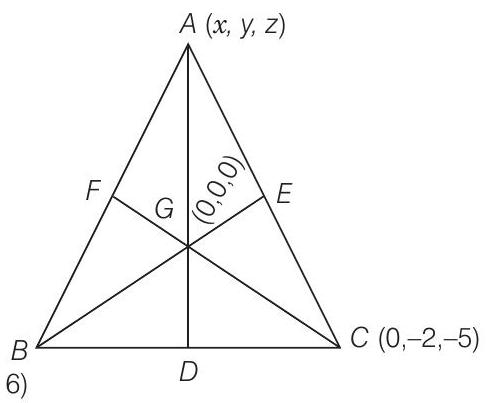
Given that, the coordinate of centroid $G$ are $(0,0,0)$.
$\because \quad \begin{aligned} 0 & =\frac{x+2+0}{3} \Rightarrow x=-2 \\ 0 & =\frac{y+4-2}{3} \Rightarrow y=-2 \\ 0 & =\frac{z+6-5}{2} \Rightarrow z=-1\end{aligned}$
Hence, the third vertex of triangle is $(-2,-2,-1)$.
12. Find the centroid of a triangle, the mid-point of whose sides are $D(1,2,-3), E(3,0,1)$ and $F(-1,1,-4)$.
Show Answer
Solution
Given that, mid-points of sides are $D(1,2,-3), E(3,0,1)$ and $F(-1,1,-4)$.
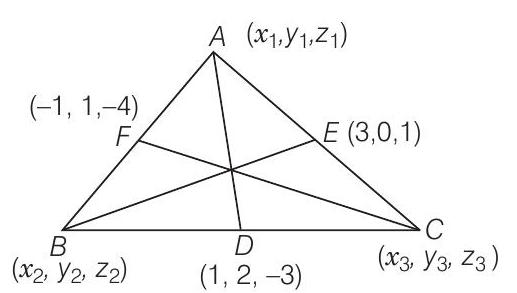
Let the vertices of the $\triangle A B C$ are $A(x_1, y_1, z_1), B(x_2, y_2, z_3)$ and $C(x_3, y_3, z_3)$.
Then, mid-point of $B C$ are $(1,2,-3)$.
$ \begin{aligned} 1 & =\frac{x_2+x_3}{2} \Rightarrow x_2+x_3=2 \\ 2 & =\frac{y_2+y_3}{2} \Rightarrow y_2+y_3=4 \\ -3 & =\frac{z_2+z_3}{2} \Rightarrow z_2+z_3=-6 \end{aligned} $
Similarly for the sides $A B$ and $A C$,
$ \begin{matrix} \Rightarrow & -1=\frac{x_1+x_2}{2} \Rightarrow x_1+x_2=-2 \\ \Rightarrow & 1=\frac{y_1+y_2}{2} \Rightarrow y_1+y_2=2 \\ \Rightarrow & -4=\frac{z_1+z_2}{2} \Rightarrow z_1+z_2=-8 \\ \Rightarrow & 3=\frac{x_1+x_3}{2} \Rightarrow x_1+x_3=6 \\ \Rightarrow & 0=\frac{y_1+y_3}{2} \Rightarrow y_1+y_3=0 \\ \Rightarrow & 1=\frac{z_1+z_3}{2} \Rightarrow z_1+z_3=2 . \end{matrix} $
On adding Eqs. (i) and (iv), we get
On adding Eqs. (ii) and (v), we get
$ x_1+2 x_2+x_3=0 $
On adding Eqs. (iii) and (vi), we get
$ y_1+2 y_2+y_3=6 $
From Eqs. (vii) and (x),
$ z_1+2 z_2+z_3=-14 $
If $x_2=-3$, then $x_3=5$
$ 2 x_2=-6 \Rightarrow x_2=-3 $
If $x_3=5$, then $x_1=1, x_2=-3, x_3=5$
From Eqs. (xi) and (viii),
$ 2 y_2=6 \Rightarrow y_2=3 $
If $y_2=3$, then $y_1=-1 \quad$ If $y_1=-1$, then $y_3=1, \quad y_2=3, y_3=1$
From Eqs. (xii) and (ix),
$ \begin{gathered} 2 z_2=-16 \Rightarrow z_2=-8 \\ z_2=-8, \text { then } z_1=0 \\ z_1=0, \text { then } z_3=2 \\ z_1=0, z_2=-8, z_3=2 \end{gathered} $
So, the points are $A(1-1,0), B(-3,3,-8)$ and $C(5,1,2)$.
$\therefore$ Centroid of the triangle $=G \frac{1-3+5}{3}, \frac{-1+3+1}{3}, \frac{0-8+2}{3}$ i.e., $G(1,1,-2)$
13. The mid-points of the sides of a triangle are $(5,7,11),(0,8,5)$ and $(2,3,-1)$. Find its vertices.
Show Answer
Solution
Let vertices of the $\triangle A B C$ are $A(x_1, y_1, z_1), B(x_2, y_2, z_2)$ and $C(x_3, y_3, z_3)$, then the mid-point of $B C(5,7,11)$.
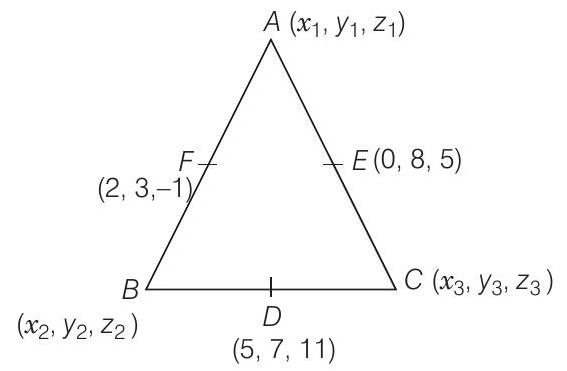
$ \begin{aligned} & 5=\frac{x_2+x_3}{2} \Rightarrow x_2+x_3=10 \\ & 7=\frac{y_2+y_3}{2} \Rightarrow y_2+y_3=14 \\ & 11=\frac{z_2+z_3}{2} \Rightarrow z_2+z_3=22 \end{aligned} $
Similarly for the sides $A B$ and $A C$,
$ \begin{gathered} 2=\frac{x_1+x_2}{2} \Rightarrow x_1+x_2=4 \\ 3=\frac{y_1+y_2}{2} \Rightarrow y_1+y_2=6 \\ -1=\frac{z_1+z_2}{2} \Rightarrow z_1+z_2=-2 \\ 0=\frac{x_1+x_3}{2} \Rightarrow x_1+x_3=0 \\ 8=\frac{y_1+y_3}{2} \Rightarrow y_1+y_3=16 \\ 5=\frac{z_1+z_3}{2} \Rightarrow z_1+z_3=10 \end{gathered} $
From Eqs. (i) and (iv),
$ x_1+2 x_2+x_3=14 $
From Eqs. (ii) and (v),
From Eqs. (iii) and (vi),
$ y_1+2 y_2+y_3=20 $
From Eqs. (vii) and (x),
From Eqs. (viii) and (xi),
$ z_1+2 z_2+z_3=20 $
$ \begin{aligned} 2 x_2 & =14 \Rightarrow x_2=7 \\ x_2 & =7, \text { then } x_3=10-7=3 \\ x_3 & =3, \text { then } x_1=-3 \\ x_1 & =-3, x_2=7, x_3=3 \end{aligned} $
$ \begin{aligned} 2 y_2 & =4 \Rightarrow y_2=2 \\ y_2 & =2, \text { then } y_1=4 \\ y_1 & =4, \text { then } y_3=12 \\ y_1 & =4, y_2=2, y_3=12 \end{aligned} $
From Eqs. (ix) and (xii),
$ \begin{aligned} 2 z_2 & =10 \Rightarrow z_2=5 \\ z_2 & =5, \text { then } z_1=-7 \\ z_1 & =-7, \text { then } z_3=17 \\ z_1 & =-7, z_2=5, z_3=17 \end{aligned} $
So, the vertices are $A(-3,4,-7), B(7,2,5)$ and $C(3,12,17)$.
14. If the vertices of a parallelogram $A B C D$ are $A(1,2,3), B(-1,-2,-1)$ and $C(2,3,2)$, then find the fourth vertex $D$.
Show Answer
Thinking Process
The diagonal of a parallelogram have the same vertices. Use this property to solve the problem.
Solution
Let the fourth vertex of the parallelogram $A B C D$ is $D(x, y, z)$. Then, the mid-point of $A C$ are
$ P \frac{1+2}{2}, \frac{2+3}{2}, \frac{3+2}{2} \text { i.e., } P \frac{3}{2}, \frac{5}{2}, \frac{5}{2} \text {. } $
Now, mid-point of $B D$,
$ \begin{aligned} & \frac{3}{2}=\frac{-1+x}{2} \Rightarrow x=4 \\ & \frac{5}{2}=\frac{-2+y}{2} \Rightarrow y=7 \\ & \frac{5}{2}=\frac{-1+z}{2} \Rightarrow z=6 \end{aligned} $
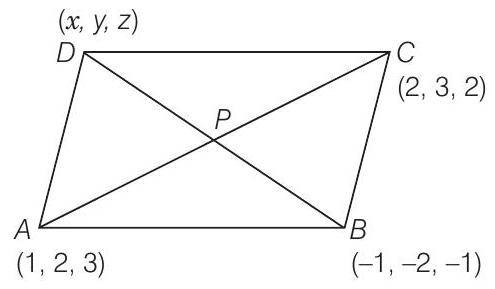
So, the coordinates of fourth vertex is $(4,7,6)$.
15. Find the coordinate of the points which trisect the line segment joining the points $A(2,1,-3)$ and $B(5,-8,3)$.
Show Answer
Thinking Process
If point $P$ divided line segment joint the point $A(x_1, y_1, z_1)$ and $B(x_2, y_2, z_2)$ in $m_1: m_2$ internally then the coordinate of $P$ are $\frac{m_1 x_2+m_2 x_1}{m_1+m_2}, \frac{m_1 y_2+m_2 y_1}{m_1+m_2}, \frac{m_1 z_2+m_2 z_1}{m_1+m_2}$
Solution
Let the $P(x_1, y_1, z_1)$ and $Q(x_2, y_2, z_2)$ trisect line segment $A B$.

Since, the point $P$ divided line $A B$ in $1: 2$ internally, then
$ \begin{aligned} & x_1=\frac{2 \times 2+1 \times 5}{1+2}=\frac{9}{3}=3 \\ & y_1=\frac{2 \times 1+1 \times(-8)}{3}=\frac{-6}{3}=-2 \\ & z_1=\frac{2 \times(-3)+1 \times 3}{3}=\frac{-6+3}{3}=\frac{-3}{3}=-1 \end{aligned} $
Since, the point $Q$ divide the line segment $A B$ in $2: 1$, then
$ \begin{aligned} & x_2=\frac{1 \times 2+2 \times 5}{3}=4, \\ & y_2=\frac{1 \times 1+(-8 \times 2)}{3}=-5 \\ & z_2=\frac{1 \times(-3)+2 \times 3}{3}=-1 \end{aligned} $
So, the coordinates of $P$ are $(3,-2,-1)$ and the coordinates of $Q$ are $(4,-5,1)$.
16. If the origin is the centroid of a $\triangle A B C$ having vertices $A(a, 1,3)$, $B(-2, b,-5)$ and $C(4,7, c)$, then find the values of $a, b, c$.
Show Answer
Solution
Given that origin is the centroid of the $\triangle A B C$ i.e., $G(0,0,0)$.
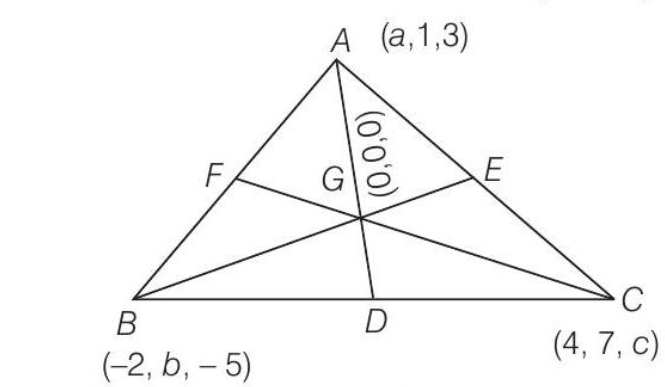
$\begin{array}{ll} \because \quad 0=\frac{a-2+4}{3} \Rightarrow a=-2 \\ 0=\frac{1+b+7}{3} \Rightarrow b=-8 \\ \quad 0=\frac{3-5+c}{3} \Rightarrow c=+2 \\ \therefore \quad a=-2, b=-8 \text { and } c=2 \end{array}$
17. If $A(2,2,-3), B(5,6,9), C(2,7,9)$ be the vertices of a triangle. The internal bisector of the angle $A$ meets $B C$ at the point $D$, then find the coordinates of $D$.
Show Answer
Solution
Let the coordinates of $D$ are $(x, y, z)$.
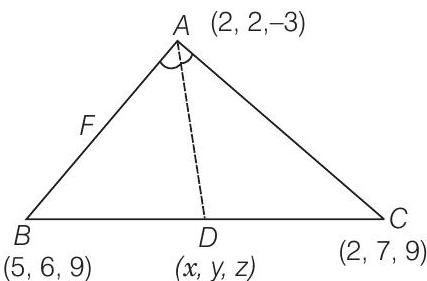
$ \begin{aligned} A B & =\sqrt{9+16+144}=\sqrt{169}=13 \\ A C & =\sqrt{0+25+144}=\sqrt{169}=\sqrt{13} \\ \frac{A B}{A C} & =\frac{13}{13} \Rightarrow A B=A C \\ \frac{B D}{D C} & =\frac{1}{1} \Rightarrow B D=D C \end{aligned} $
$ \Rightarrow \quad \frac{A B}{A C}=\frac{13}{13} \Rightarrow A B=A C $
Since, $D$ is divide the line $B C$ in two equal parts. So, $D$ is the mid-point of $B C$.
$ \begin{matrix} \therefore & x=\frac{5+2}{2}=7 / 2 \\ \Rightarrow & y=\frac{6+7}{2}=13 / 2 \\ \Rightarrow & z=\frac{9+9}{2}=9 \end{matrix} $
So, the coordinates of $D$ are $\frac{7}{2}, \frac{13}{2}, 9$.
Long Answer Type Questions
18. Show that the three points $A(2,3,4), B(1,2,-3)$ and $C(-4,1,-10)$ are collinear and find the ratio in which $C$ divides $A B$.
Show Answer
Solution
Given points are $A(2,3,4), B(-1,2,-3)$ and $C(-4,1,-10)$.
$ \begin{aligned} & \therefore \quad A B=\sqrt{(2+1)^{2}+(3-2)^{2}+(4+3)^{2}} \\ & =\sqrt{9+1+49}=\sqrt{59} \\ & B C=\sqrt{(-1+4)^{2}+(2-1)^{2}+(-3+10)^{2}} \\ & =\sqrt{9+1+49}=\sqrt{59} \\ & A C=\sqrt{(2+4)^{2}+(3-1)^{2}+(4+10)^{2}} \\ & =\sqrt{36+4+196} \\ & =\sqrt{236}=2 \sqrt{59} \\ & A B+B C=\sqrt{59}+\sqrt{59}=2 \sqrt{59} \end{aligned} $
19. The mid-point of the sides of a triangle are $(1,5,-1),(0,4,-2)$ and $(2,3,4)$. Find its vertices and also find the centroid of the triangle.
Show Answer
Solution
Let the vertices of $\triangle A B C$ are $A(x_1, y_1, z_1), B(x_2, y_2, z_2)$ and $C(x_3, y_3, z_3)$.
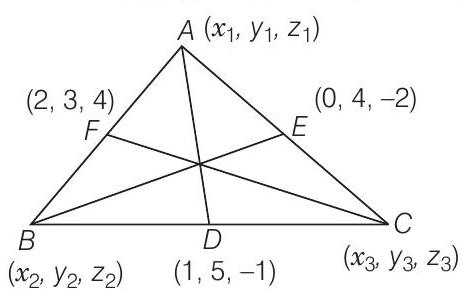
Since, the mid-point of side $B C$ is $D(1,5,-1)$.
Then,
$ \begin{aligned} & \frac{x_2+x_3}{2}=1 \Rightarrow x_2+x_3=2 \\ & \frac{y_2+y_3}{2}=5 \Rightarrow y_2+y_3=10 \\ & \frac{z_2+z_3}{2}=-1 \Rightarrow z_2+z_3=-2 \end{aligned} $
Similarly, the mid-points of $A B$ and $A C$ are $F(2,3,4)$ and $E(0,4,-2)$,
and
$ \begin{aligned} & \frac{x_1+x_2}{2}=2 \Rightarrow x_1+x_2=4 \\ & \frac{y_1+y_2}{2}=3 \Rightarrow y_1+y_2=6 \\ & \frac{z_1+z_2}{2}=4 \Rightarrow z_1+z_2=8 \end{aligned} $
Now,
$ \begin{gathered} \frac{x_1+x_3}{2}=0 \Rightarrow x_1+x_3=0 \\ \frac{y_1+y_3}{2}=4 \Rightarrow y_1+y_3=8 \\ \frac{z_1+z_3}{2}=-2 \Rightarrow z_1+z_3=-4 \end{gathered} $
From Eqs. (i) and (iv),
From Eqs. (ii) and (v),
$ x_1+2 x_2+x_3=6 $
From Eqs. (iii) and (vi),
$ y_1+2 y_2+y_3=16 $
From Eqs. (vii) and (x),
Then,
$ z_1+2 z_2+z_3=6 $
From Eqs. (viii) and (xi),
Then,
$ \begin{aligned} 2 x_2 & =6 \Rightarrow x_2=3 \\ x_2 & =3, \text { then } x_3=-1 \\ x_3 & =-1 \\ x_1 & =1 \Rightarrow x_1=1, x_2=3, x_2=-1 \end{aligned} $
$ \begin{aligned} 2 y_2 & =8 \Rightarrow y_2=4 \\ y_2 & =4 \\ y_1 & =2 \\ y_1 & =2 \\ y_3 & =6 \\ y_1 & =2, y_2=4, y_3=6 \end{aligned} $
$ \Rightarrow $
From Eqs. (ix) and (xii),
Then,
$ \begin{aligned} 2 z_2 & =10 \Rightarrow z_2=5 \\ z_2 & =5 \end{aligned} $
$ z_1=3 $
$ z_1=3, $
Then,
$ z_3=-7 $
$\Rightarrow$
$ z_1=3, z_2=5, z_3=-7 $
So, the vertices of the triangle $A(1,2,3), B(3,4,5)$ and $C(-1,6,-7)$.
Hence, centroid of the triangle $G \frac{1+3-1}{3}, \frac{2+4+6}{3}, \frac{3+5-7}{3}$ i.e., $G(1,4,1 / 3)$.
20. Prove that the points $(0,-1,-7),(2,1,-9)$ and $(6,5,-13)$ are collinear. Find the ratio in which the first point divides the join of the other two.
Show Answer
Thinking Process
First of all find the value of $A B, A C$ and $B C$ using distance formula i.e. $\sqrt{(x_1-x_2)^{2}+(y_1-y_2)+(z_1-z_2)^{2}}$, then show that $A B+B C=A C$ for collinearity of the points $A, B$ and $C$.
Solution
Given points are $A(0,-1,-7), B(2,1,-9)$ and $C(6,5,-13)$
$ \begin{aligned} & A B=\sqrt{(0-2)^{2}+(-1-1)^{2}+(-7+9)^{2}}=\sqrt{4+4+4}=2 \sqrt{3} \\ & B C=\sqrt{(2-6)^{2}+(1-5)^{2}+(-9+13)^{2}}=\sqrt{16+16+16}=4 \sqrt{3} \\ & A C=\sqrt{(0-6)^{2}+(-1-5)^{2}+(-7+13)^{2}}=\sqrt{36+36+36}=6 \sqrt{3} \end{aligned} $
$ \begin{matrix} \because & A B+B C=2 \sqrt{3}+4 \sqrt{3}=6 \sqrt{3} \\ \text { So, } & A B+B C=A C \\ \text { Hence, the points } A, B \text { and } C \text { are collinear. } \\ & A \quad B \quad B \\ & A B: A C=2 \sqrt{3}: 6 \sqrt{3}=1: 3 \end{matrix} $
So, point $A$ divide $B$ and $C$ in $1: 3$ externally,
21. What are the coordinates of the vertices of a cube whose edge is 2 units, one of whose vertices coincides with the origin and the three edges passing through the origin, coincides with the positive direction of the axes through the origin?
Show Answer
Solution
The coordinates of the cube which edge is 2 units, are $(2,0,0),(2,2,0),(0,2,0)$, $(0,2,2),(0,0,2),(2,0,2),(0,0,0)$ and $(2,2,2)$.
Objective Type Questions
22. The distance of point $P(3,4,5)$ from the $Y Z$-plane is
(a) 3 units
(b) 4 units
(c) 5 units
(d) 550
Show Answer
Solution
(a) Given, point is $P(3,4,5)$.
Distance of $P$ from YZ-plane, $\quad[\because Y Z$-plane, $x=0]$
$ d=\sqrt{(0-3)^{2}+(4-4)^{2}+(5-5)^{2}}=3 $
-
Option (b) 4 units: This is incorrect because the distance of a point from the YZ-plane is determined by the x-coordinate of the point. In this case, the x-coordinate is 3, not 4.
-
Option (c) 5 units: This is incorrect because the distance of a point from the YZ-plane is determined by the x-coordinate of the point. In this case, the x-coordinate is 3, not 5.
-
Option (d) 550: This is incorrect because the distance of a point from the YZ-plane is determined by the x-coordinate of the point. In this case, the x-coordinate is 3, and 550 is an unrelated and excessively large number.
23. What is the length of foot of perpendicular drawn from the point $P$ $(3,4,5)$ on $Y$-axis?
(a) $\sqrt{41}$
(b) $\sqrt{34}$
(c) 5
(d) None of these
Show Answer
Solution
(b) We know that, on the $Y$-axis, $x=0$ and $z=0$.
$\therefore$ Point $A(0,4,0)$,
$ \begin{aligned} P A & =\sqrt{(0-3)^{2}+(4-4)^{2}+(0-5)^{2}} \\ & =\sqrt{9+0+25}=\sqrt{34} \end{aligned} $
-
Option (a) $\sqrt{41}$ is incorrect because the calculation of the distance from point $P(3,4,5)$ to point $A(0,4,0)$ on the $Y$-axis does not result in $\sqrt{41}$. The correct distance is $\sqrt{34}$ as shown in the solution.
-
Option (c) 5 is incorrect because the distance from point $P(3,4,5)$ to point $A(0,4,0)$ on the $Y$-axis is not 5. The correct distance is $\sqrt{34}$ as calculated.
-
Option (d) None of these is incorrect because there is a correct option provided, which is (b) $\sqrt{34}$.
24. Distance of the point $(3,4,5)$ from the origin $(0,0,0)$ is
(a) $\sqrt{50}$
(b) 3
(c) 4
(d) 5
Show Answer
Solution
(a) Given, points $P(3,4,5)$ and $O(0,0,0)$,
$ \begin{aligned} P O & =\sqrt{(0-3)^{2}+(0-4)^{2}+(0-5)^{2}} \\ & =\sqrt{9+16+25}=\sqrt{50} \end{aligned} $
- Option (b) is incorrect because the distance calculated as 3 would imply that the sum of the squares of the differences in coordinates is 9, which is not the case here.
- Option (c) is incorrect because the distance calculated as 4 would imply that the sum of the squares of the differences in coordinates is 16, which is not the case here.
- Option (d) is incorrect because the distance calculated as 5 would imply that the sum of the squares of the differences in coordinates is 25, which is not the case here.
25. If the distance between the points $(a, 0,1)$ and $(0,1,2)$ is $\sqrt{27}$, then the value of $a$ is
(a) 5
(b) $\pm 5$
(c) -5
(d) None of these
Show Answer
Solution
(b) Given, the points are $A(a, 0,1)$ and $B(0,1,2)$.
$ \begin{matrix} \therefore & A B=\sqrt{(a-0)^{2}+(0-1)^{2}+(1-2)^{2}} \\ \Rightarrow & \sqrt{27}=\sqrt{a^{2}+1+1} \\ \Rightarrow & 27=a^{2}+2 \\ \Rightarrow & a^{2}=25 \\ \Rightarrow & a= \pm 5 \end{matrix} $
-
Option (a) 5: This option is partially correct because it only considers the positive root of the equation (a^2 = 25). However, the equation has two solutions, (a = 5) and (a = -5).
-
Option (c) -5: This option is also partially correct because it only considers the negative root of the equation (a^2 = 25). The equation has two solutions, (a = 5) and (a = -5).
-
Option (d) None of these: This option is incorrect because the correct value of (a) is (\pm 5), which is provided in option (b).
26. $X$-axis is the intersection of two planes
(a) $X Y$ and $X Z$
(b) $Y Z$ and $Z X$
(c) $X Y$ and $Y Z$
(d) None of these
Show Answer
Solution
(a) We know that, on the $X Y$ and $X Z$-planes, the line of intersection is $X$-axis.
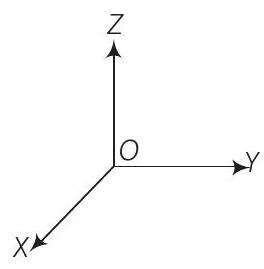
- Option (b) is incorrect because the intersection of the planes ( YZ ) and ( ZX ) is the ( Z )-axis, not the ( X )-axis.
- Option (c) is incorrect because the intersection of the planes ( XY ) and ( YZ ) is the ( Y )-axis, not the ( X )-axis.
- Option (d) is incorrect because option (a) is correct, making “None of these” an invalid choice.
27. Equation of $Y$-axis is considered as
(a) $x=0, y=0$
(b) $y=0, z=0$
(c) $z=0, x=0$
(d) None of these
Show Answer
Solution
(c) On the Y-axis, $x=0$ and $z=0$.
- Option (a) $x=0, y=0$: This option is incorrect because $y=0$ represents the XZ-plane, not the Y-axis. The Y-axis is defined by $x=0$ and $z=0$.
- Option (b) $y=0, z=0$: This option is incorrect because $y=0$ and $z=0$ represent the X-axis, not the Y-axis. The Y-axis is defined by $x=0$ and $z=0$.
- Option (d) None of these: This option is incorrect because there is a correct option provided, which is (c) $z=0, x=0$.
28. The point $(-2,-3,-4)$ lies in the
(a) first octant
(b) seventh octant
(c) second octant
(d) eight octant
Show Answer
Solution
(b) The point $(-2,-3,-4)$ lies in seventh octant.
- The point $(-2,-3,-4)$ does not lie in the first octant because in the first octant, all coordinates (x, y, z) are positive.
- The point $(-2,-3,-4)$ does not lie in the second octant because in the second octant, x is negative, y is positive, and z is positive.
- The point $(-2,-3,-4)$ does not lie in the eighth octant because in the eighth octant, x is positive, y is negative, and z is negative.
29. A plane is parallel to $Y Z$-plane, so it is perpendicular to
(a) $X$-axis
(b) $Y$-axis
(c) Z-axis
(d) None of these
Show Answer
Solution
(a) A plane is parallel to YZ-plane, so it is perpendicular to $X$-axis.
- (b) A plane parallel to the YZ-plane is not perpendicular to the Y-axis because it lies parallel to both the Y and Z axes.
- (c) A plane parallel to the YZ-plane is not perpendicular to the Z-axis because it lies parallel to both the Y and Z axes.
- (d) The option “None of these” is incorrect because the plane is indeed perpendicular to the X-axis.
30. The locus of a point for which $y=0$ and $z=0$, is
(a) equation of $X$-axis
(b) equation of $Y$-axis
(c) equation at Z-axis
(d) None of these
Show Answer
Solution
(a) We know that, equation on the $X$-axis, $y=0, z=0$. So, the locus of the point is equation of $X$-axis.
- (b) The equation of the $Y$-axis is given by $x=0$ and $z=0$, not $y=0$ and $z=0$.
- (c) The equation of the $Z$-axis is given by $x=0$ and $y=0$, not $y=0$ and $z=0$.
- (d) The given conditions $y=0$ and $z=0$ do correspond to a known axis, specifically the $X$-axis, so this option is incorrect.
31. The locus of a point for which $x=0$ is
(a) $X Y$-plane
(b) YZ-plane
(c) ZX-plane
(d) None of these
Show Answer
Solution
(b) On the YZ-plane, $x=0$, hence the locus of the point is $Y Z$-plane.
-
(a) $XY$-plane: On the $XY$-plane, $z=0$, not $x=0$. Therefore, the locus of the point where $x=0$ cannot be the $XY$-plane.
-
(c) $ZX$-plane: On the $ZX$-plane, $y=0$, not $x=0$. Therefore, the locus of the point where $x=0$ cannot be the $ZX$-plane.
-
(d) None of these: This option is incorrect because there is a correct option, which is the $YZ$-plane where $x=0$.
32. If a parallelopiped is formed by planes drawn through the points $(5,8,10)$ and $(3,6,8)$ parallel to the coordinate planes, then the length of diagonal of the parallelopiped is
(a) $2 \sqrt{3}$
(b) $3 \sqrt{2}$
(c) $\sqrt{2}$
(d) $\sqrt{3}$
Show Answer
Solution
(a) Given points of the parallelopiped are $A(5,8,10)$ and $B(3,6,8)$.
$ \begin{aligned} \therefore \quad A B & =\sqrt{(5-3)^{2}+(6-8)^{2}+(10-8)^{2}} \\ & =\sqrt{4+4+4}=2 \sqrt{3} \end{aligned} $
-
Option (b) $3 \sqrt{2}$: This option is incorrect because the calculation of the diagonal length does not result in $3 \sqrt{2}$. The correct calculation involves the square root of the sum of the squares of the differences in the coordinates, which yields $2 \sqrt{3}$, not $3 \sqrt{2}$.
-
Option (c) $\sqrt{2}$: This option is incorrect because the calculation of the diagonal length does not result in $\sqrt{2}$. The correct calculation involves the square root of the sum of the squares of the differences in the coordinates, which yields $2 \sqrt{3}$, not $\sqrt{2}$.
-
Option (d) $\sqrt{3}$: This option is incorrect because the calculation of the diagonal length does not result in $\sqrt{3}$. The correct calculation involves the square root of the sum of the squares of the differences in the coordinates, which yields $2 \sqrt{3}$, not $\sqrt{3}$.
33. $L$ is the foot of the perpendicular drawn from a point $P(3,4,5)$ on the $X Y$-plane. The coordinates of point $L$ are
(a) $(3,0,0)$
(b) $(0,4,5)$
(c) $(3,0,5)$
(d) None of these
Show Answer
Solution
(d) We know that, on the $X Y$-plane $z=0$. Hence, the coordinates of the points $L$ are $(3,4,0)$.
- Option (a) $(3,0,0)$ is incorrect because it does not preserve the $x$ and $y$ coordinates of point $P(3,4,5)$. The $y$ coordinate should be 4, not 0.
- Option (b) $(0,4,5)$ is incorrect because it does not set the $z$ coordinate to 0, which is required for a point on the $XY$-plane. The $z$ coordinate should be 0, not 5.
- Option (c) $(3,0,5)$ is incorrect because it does not set the $z$ coordinate to 0, which is required for a point on the $XY$-plane. The $z$ coordinate should be 0, not 5.
34. $L$ is the foot of the perpendicular drawn from a point $(3,4,5)$ on $X$-axis. The coordinates of $L$ are
(a) $(3,0,0)$
(b) $(0,4,0)$
(c) $(0,0,5)$
(d) None of these
Show Answer
Solution
(a) On the X-axis, $y=0$ and $z=0$
Hence, the required coordinates are $(3,0,0)$.
- Option (b) $(0,4,0)$ is incorrect because on the X-axis, the $y$-coordinate must be $0$, but here it is $4$.
- Option (c) $(0,0,5)$ is incorrect because on the X-axis, the $z$-coordinate must be $0$, but here it is $5$.
- Option (d) None of these is incorrect because the correct coordinates $(3,0,0)$ are provided in option (a).
Fillers
35. The three axes $O X, O Y$ and $O Z$ determine ……
Show Answer
Solution
The three axes $O X, O Y$ and $O Z$ determine three coordinates planes.
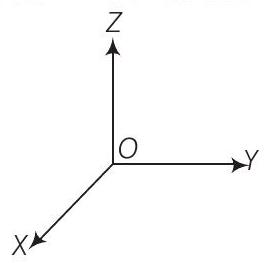
36. The three planes determine a rectangular parallelopiped which has …… of rectangular faces.
Show Answer
Solution
Three points
37. The coordinates of a point are the perpendicular distance from the …… on the respectives axes.
Show Answer
Solution
Given points
38. The three coordinate planes divide the space into …… parts.
Show Answer
Solution
Eight parts
39. If a point $P$ lies in $Y Z$-plane, then the coordinates of a point on $Y Z$-plane is of the form ……
Show Answer
Solution
We know that, on YZ-plane, $x=0$. So, the coordinates of the required point is $(0, y, z)$.
40. The equation of $Y Z$-plane is ……
Show Answer
Solution
The equation of YZ-plane is $x=0$.
41. If the point $P$ lies on $Z$-axis, then coordinates of $P$ are of the form ……
Show Answer
Solution
On the $Z$-axis, $x=0$ and $y=0$. So, the required coordinates are $(0,0, z)$.
42. The equation of $Z$-axis, are ……
Show Answer
Solution
The equation of $Z$-axis, $x=0$ and $y=0$.
43. $A$ line is parallel to $X Y$-plane if all the points on the line have equal ……
Show Answer
Solution
z-coordinates.
44. $A$ line is parallel to $X$-axis, if all the points on the line have equal ……
Show Answer
Solution
$y$ and $z$-coordinates.
45. $x=a$ represent a plane parallel to ……
Show Answer
Solution
$x=$ a represent a plane parallel to $Y Z$-plane.
46. The plane parallel to $Y Z$-plane is perpendicular to ……
Show Answer
Solution
The plane parallel to $Y Z$-plane is perpendicular to $X$-axis.
47. The length of the longest piece of a string that can be stretched straight in a rectangular room whose dimensions are 10,13 and 8 units are ……
Show Answer
Solution
Given dimensions are $a=10, b=13$ and $c=8$.
$ \begin{aligned} \therefore \quad \text { Required length } & =\sqrt{a^{2}+b^{2}+c^{2}} \\ & =\sqrt{100+169+64}=\sqrt{333} \end{aligned} $
48. If the distance between the points $(a, 2,1)$ and $(1,-1,1)$ is 5 , then $a$ ……
Show Answer
Solution
Given points are $(a, 2,1)$ and $(1,-1,1)$.
$ \begin{matrix} \therefore & \sqrt{(a-1)^{2}+(2+1)^{2}+(1-1)^{2}} & =5 \\ \Rightarrow & (a-1)^{2}+9+0 & =25 \\ \Rightarrow & a^{2}-2 a+1+9 & =25 \\ \Rightarrow & a^{2}-2 a-15 & =0 \\ \Rightarrow & a^{2}-5 a+3 a-15 & =0 \\ \Rightarrow & a(a-5)+3(a-5) & =0 \\ \Rightarrow & (a-5)(a+3) & =0 \\ \Rightarrow & a-5=0 \text { or } a+3 & =0 \\ \therefore & a & =+5 \text { or }-3 \end{matrix} $
49. If the mid-points of the sides of a triangle $A B, B C$ and $C A$ are $D(1,2,-3)$, $E(3,0,1)$ and $F(-1,1,-4)$, then the centroid of the $\triangle A B C$ is ……
Show Answer
Solution
Let the vertices of $\triangle A B C$ is $A(x_1, y_1, z_1), B(x_2, y_2, z_2)$ and $C(x_3, y_3, z_3)$.
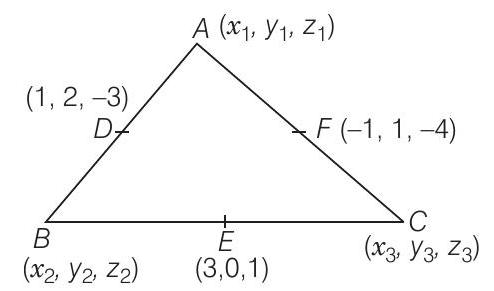
Since, $D$ is the mid-point of $A B$, then
$ \begin{aligned} & \frac{x_1+x_2}{2}=1 \Rightarrow x_1+x_2=2 \\ & \frac{y_1+y_2}{2}=2 \Rightarrow y_1+y_2=4 \\ & \frac{z_1+z_2}{2}=-3 \Rightarrow z_1+z_2=-6 \end{aligned} $
Similarly, $E$ and $F$ are the mid-points of sides $B C$ and $A C$, respectively.
$ \begin{aligned} & \frac{x_2+x_3}{2}=3 \Rightarrow x_2+x_3=6 \\ & \frac{y_2+y_3}{2}=0 \Rightarrow y_2+y_3=0 \\ & \frac{z_2+z_3}{2}=1 \Rightarrow z_2+z_3=2 \\ & \frac{x_1+x_3}{2}=-1 \Rightarrow x_1+x_3=-2 \\ & \frac{y_1+y_3}{2}=1 \Rightarrow y_1+y_3=2 \\ & \frac{z_1+z_3}{2}=-4 \Rightarrow z_1+z_3=-8 \end{aligned} $
From Eqs. (i) and (iv),
$ x_1+2 x_2+x_3=8 $
From Eqs. (ii) and (v),
From Eqs. (iii) and (vi),
$ y_1+2 y_2+y_3=4 $
From Eqs. (vii) and (x),
$ z_1+2 z_2+z_3=-4 $
$\Rightarrow$
$ 2 x_2=10 \Rightarrow x_2=5 $
If $x_3=1$, then $x_1=-3$
$x_2=5$, then $x_3=1$
$\because$ From Eqs. (viii) and (xi),
If
$ x_1=-3, x_2=5, x_3=1 $
$ \begin{aligned} 2 y_2 & =2 \Rightarrow y_2=1 \\ y_2 & =1, \text { then } y_3=-1 \\ y_3 & =-1, \text { then } y_1=3 \\ y_1 & =3, y_2=1, y_3=-1 \end{aligned} $
From Eqs. (ix) and (xii),
$ \begin{aligned} 2 z_2 & =4 \Rightarrow z_2=2 \\ z_2 & =2, \text { then } z_3=0 \\ z_3 & =0, \text { then } z_1=-8 \\ z_1 & =-8, z_2=2, z_3=0 \end{aligned} $
So, the vertices of $\triangle A B C$ are $A(-3,3,-8), B(5,1,2)$ and $C(1,-1,0)$. Hence, coordinates of centroid of $\triangle A B C, G \frac{-3+5+1}{3}, \frac{3+1-1}{3}, \frac{-8+2+0}{3}$
i.e.,
$G(1,1,-2)$.
50. Match each item given under the Column I to its correct answer given under Column II.
| Column I | Column II | ||
|---|---|---|---|
| (i) | In-XY-plane | (a) | Ist octant |
| (ii) | Point $(2,3,4)$ lies in the | (b) | YZ-plane |
| (iii) | Locus of the points having $X$ coordinate 0 is |
(c) | $z$-coordinate is zero |
| (iv) | A line is parallel to $X$-axis if and only | (d) | Z-axis |
| $(v)$ | If $X=0, y=0$ taken together will represent the |
(e) | plane parallel to $X Y$-plane |
| (vi) | $z=c$ represent the plane | (f) | if all the points on the line have equal $y$ and $z$-coordinates |
| (vii) | Planes $X=a, Y=b$ represent the line | (f) | from the point on the respective |
| (viii) | Coordinates of a point are the distances from the origin to the feet of perpendiculars |
(h) | parallel to Z-axis |
| (ix) | A ball is the solid region in the space enclosed by a |
(i) | disc |
| $(x)$ | Region in the plane enclosed by a circle is known as a |
(j) | sphere |
Show Answer
Solution
(i) In XY-plane, z-coordinates is zero.
(ii) The point $(2,3,4)$ lies in 1 st octant .
(iii) Locus of the points having $x$-coordinate is zero is $Y Z$-plane.
(iv) $A$ line is parallel to $X$-axis if and only if all the points on the line have equal $y$ and $z$-coordinates.
(v) $x=0, y=0$ represent Z-axis.
(vi) $z=c$ represent the plane parallel to $X Y$-plane.
(vii) The planes $x=a, y=b$ represent the line parallel to $Z$-axis.
(viii) Coordinates of a point are the distances from the origin to the feet of perpendicular from the point on the respective.
(ix) A ball is the solid region in the space enclosed by a sphere.
(x) The region in the plane enclosed by a circle is known as a disc.






